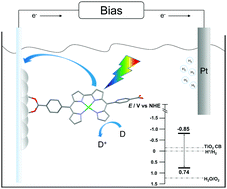A Ni-2,2′-bisdipyrrinato complex as a potential sensitizer: synthesis and photoelectrochemical characterization†
Abstract
A novel Ni-based 2,2′-bisdipyrrinato complex bearing peripheral benzoic acid groups (Ni-bisdpmCOOH) has been synthesized and characterized. Electrochemical investigations revealed a high energy LUMO level that, combined with its absorption properties extending up to the NIR region, is compatible with its use as a sensitizer in thermodynamically uphill photocatalytic reactions, such as proton and carbon dioxide photoreduction. A sensitized photo-anode was prepared by adsorbing Ni-bisdpmCOOH onto a TiO2 film, which showed an incident photon to current efficiency, measured at 0.62 V vs. RHE, extending up to the visible light region. This demonstrates that electronically excited Ni-bisdpmCOOH is effectively able to inject electrons into the conduction band of TiO2, thus opening the way for effective TiO2 sensitization or MOF implementation of the molecule itself for energetic applications.



 Please wait while we load your content...
Please wait while we load your content...